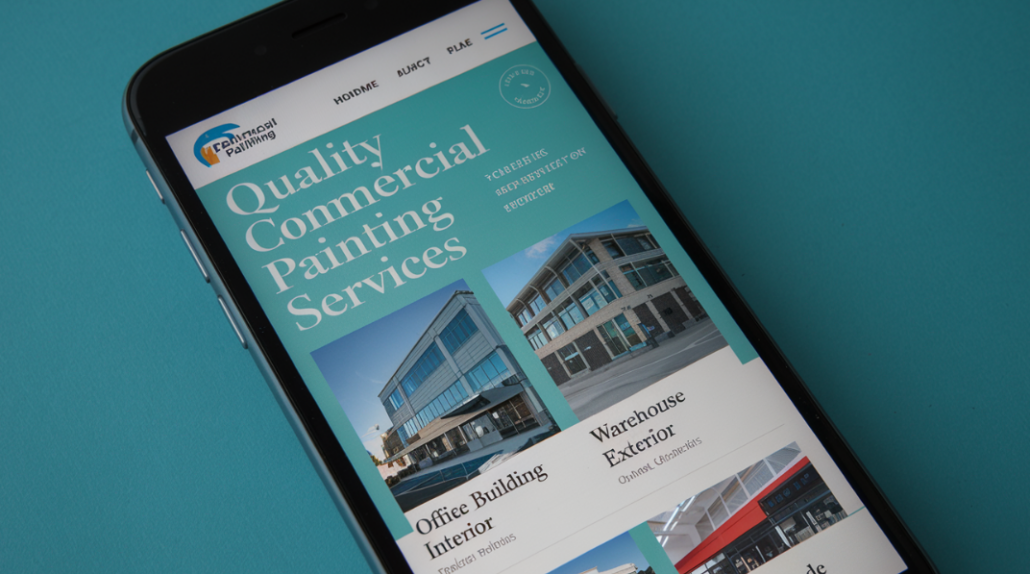

A well-designed website plays a vital role in painting companies wanting to stand out, especially in the commercial sector. Your website acts as a sales tool, representing your brand, highlighting services, and converting visitors into clients. To achieve these results, specific strategies and elements are needed for a powerful online presence suited for commercial painting businesses, with a few residential examples included. A website with quality design, clear navigation, and compelling content can build trust, attract new clients, and set your company apart from competitors.
Identify Your Audience
The first step in effective website design is identifying who your visitors are. For commercial painting companies, this audience often includes property managers, contractors, and business owners seeking dependable services. Your website should reflect professionalism, provide necessary information, and be easy to navigate. Knowing the audience also helps you create content that speaks directly to their needs, such as focusing on safety standards, timelines, and quality control, which are major concerns for commercial clients.
Key Audience Considerations:
- Professionalism: A clean, minimal design reflects the quality of your work and leaves a positive first impression.
- Detailed Information: Clear service descriptions, project portfolios, and certifications build trust and inform potential clients.
- Accessibility: Key pages should be easy to find to keep users engaged and reduce frustration when searching for information.
Core Elements of a Successful Painting Website
A great website should do more than look good—it needs to function as a marketing tool that builds trust and generates inquiries. Below are essential elements your site should have to support lead generation and showcase expertise effectively.
1. Strong Branding
Consistent branding ensures your company is memorable. Include a professional logo, cohesive color scheme, and font style that reflects your business identity. A strong brand identity conveys trust, reliability, and expertise in the painting industry, making your company instantly recognizable to returning and potential clients alike.
Example: A commercial painting company using bold colors and clean typography can signal reliability, professionalism, and attention to detail, all critical elements for building client confidence.
2. High-Quality Images
Photos showcasing past projects help potential clients see the quality of your work. Use high-resolution images of completed commercial painting jobs and residential work when relevant. Including before-and-after photos and project galleries can highlight transformation results, further emphasizing the quality of your work and ability to handle large-scale projects.
3. Clear Service Descriptions
Create dedicated pages for each service. Explain what makes your commercial painting services unique, such as:
- Types of properties served, including offices, warehouses, and retail spaces.
- Materials and techniques used for durability and safety.
- Project timelines and safety measures to reassure clients of a professional process.
This not only informs your visitors but also helps with SEO optimization when potential clients search for specific services in your area.
4. Client Reviews and Testimonials
Customer feedback builds trust. Highlight positive testimonials prominently, especially from commercial clients. Video testimonials or case studies can make even more impact. Highlight detailed reviews focusing on reliability, project success, and satisfaction to help build a trustworthy reputation among potential customers.
5. Contact Information
Make contact details easy to find. Place your phone number, email, and a contact form on every page. Adding a location map and social media links can also improve accessibility. Consider using a dedicated contact page with embedded forms for quote requests and service inquiries to streamline communication.
6. Calls to Action (CTAs)
Encourage visitors to take action with clear buttons and links. Phrases such as “Request a Quote” or “Schedule a Consultation” can guide users toward connecting with you. Effective CTAs placed strategically on service pages and the homepage can improve lead generation significantly.
7. Mobile Optimization
A majority of users browse websites on mobile devices. Your site needs to adjust to smaller screens while remaining functional and visually appealing. Mobile responsiveness is critical for both user experience and SEO, as search engines prioritize mobile-friendly websites in rankings.
SEO Best Practices for Painting Websites
Search engine optimization (SEO) helps your website rank well on search engines like Google. These strategies can improve visibility and attract more potential clients:
- Keyword Use: Include terms like “commercial painting services,” “painting company web design,” and “painter web design services.”
- Local SEO: Mention your service areas and use location-based keywords for better local visibility.
- Meta Tags: Optimize title tags, meta descriptions, and headers for better rankings and higher click-through rates.
- Image Optimization: Compress images and use alt text for accessibility and SEO. Properly labeled images help improve rankings in image search results as well.
Content Ideas for Painting Company Websites
Content is essential for both engaging users and improving search rankings. Consider these ideas for your painting company website to keep content fresh and informative:
- Project Spotlights: Write detailed posts about completed jobs, including project challenges and how they were solved.
- Blogs: Share tips on property maintenance, color selection, and industry trends to position yourself as a helpful resource.
- FAQs: Answer common questions about commercial painting projects, such as timelines, material choices, and warranty coverage.
- Video Content: Provide walkthroughs of completed jobs or interviews with team members to create a personal connection with your audience.
Technical Features Your Website Needs
Modern painting company websites need more than great visuals and content. These technical aspects ensure your site performs well and keeps users engaged:
- Fast Loading Speed: Optimize images and code to reduce load times, improving user experience.
- Secure Hosting: Use SSL certificates to protect data and improve trust with visitors.
- Accessibility Compliance: Design with ADA standards in mind to ensure inclusivity for all users.
- Analytics Integration: Tools like Google Analytics can help track performance, and visitor behavior, and optimize marketing strategies.
How a Great Website Impacts Your Painting Business
A professional website can help painting companies achieve key business goals:
- Build credibility with a polished appearance and strong brand representation.
- Attract high-value commercial contracts through effective service presentation.
- Generate more inquiries and leads with clear CTAs and accessible contact forms.
- Improve online visibility with optimized SEO strategies.
Final Thoughts
Designing an effective painting company website involves more than just visual appeal. When you focus on user experience, SEO, and technical performance, your site can become a marketing tool that drives long-term business growth. Whether you specialize in commercial painting or offer residential services, a professional website plays a key role in standing out in today’s competitive market.












